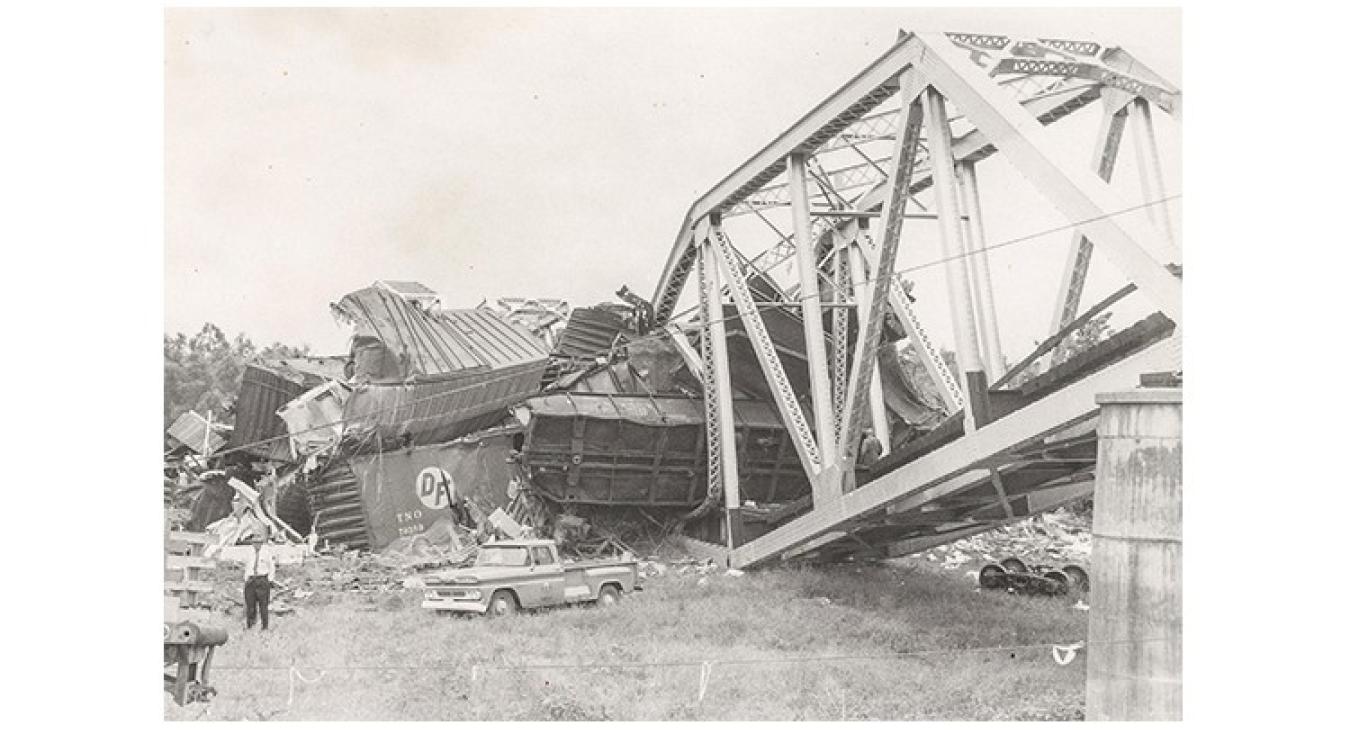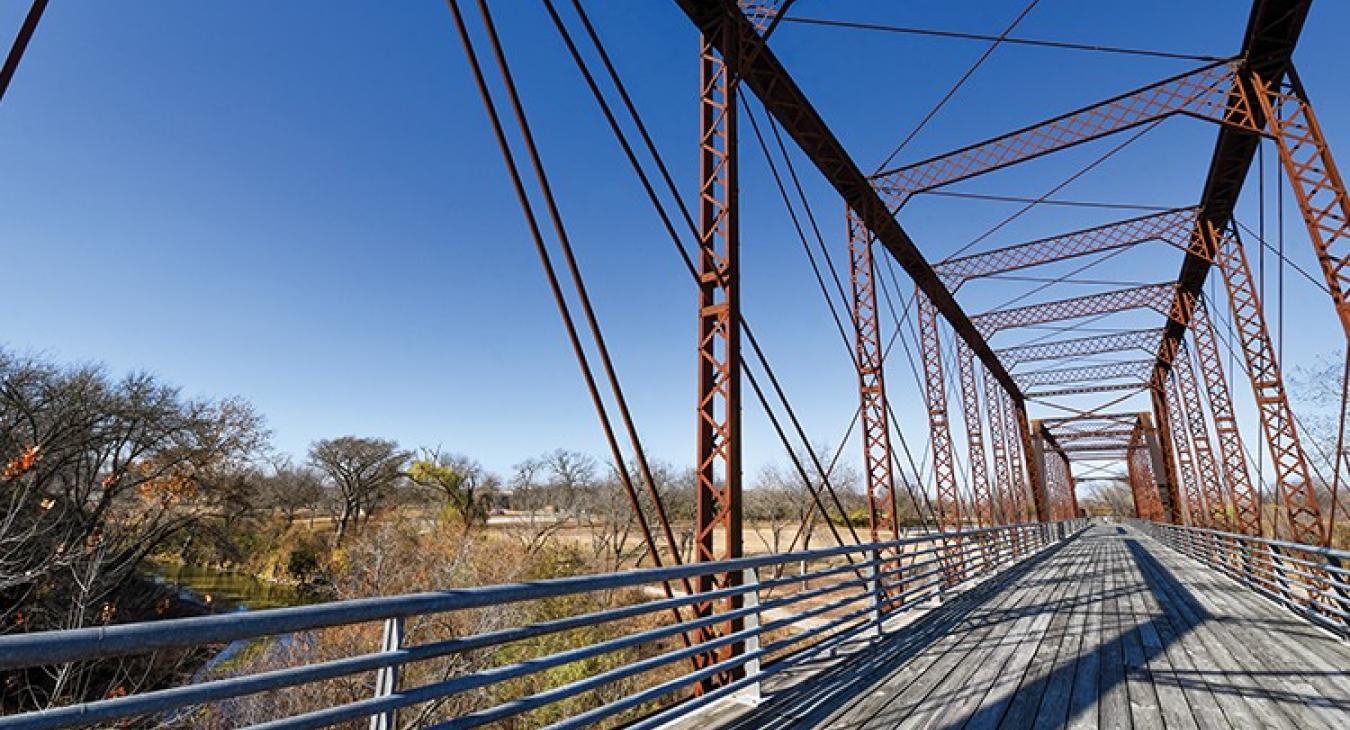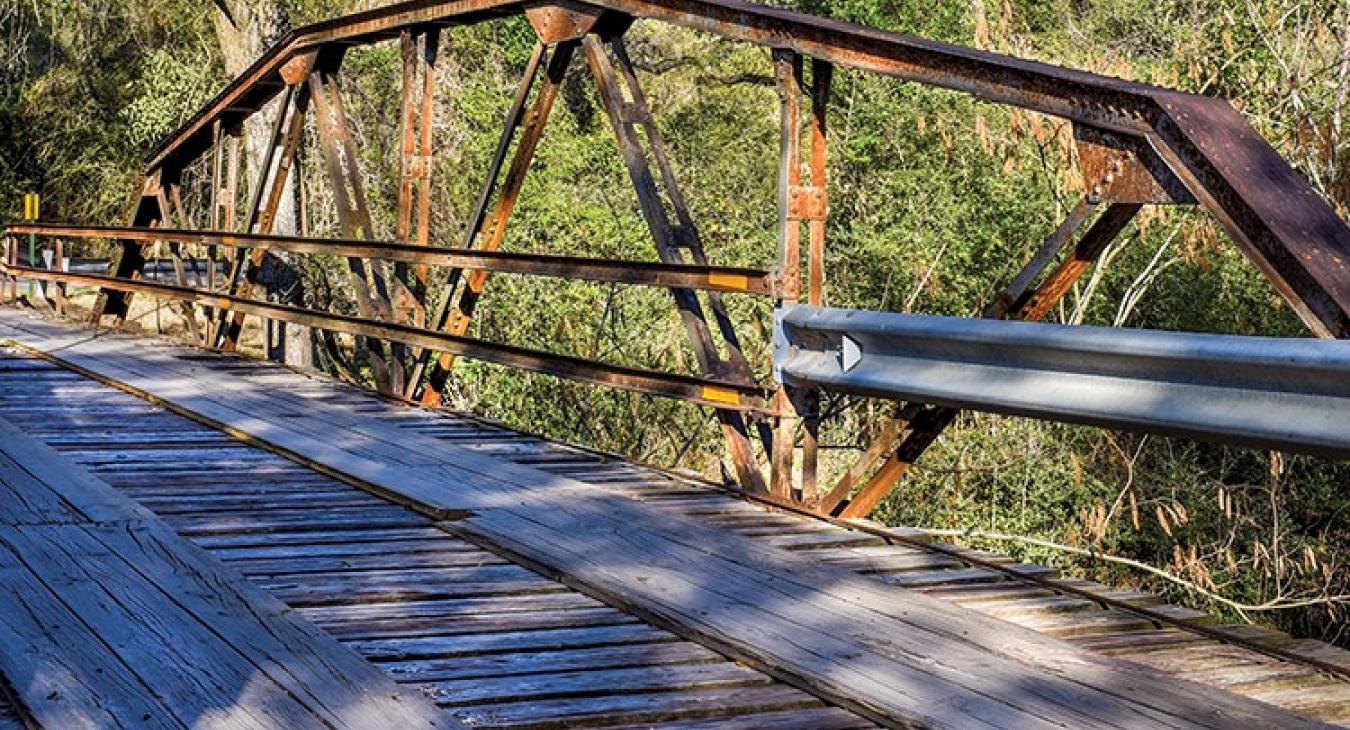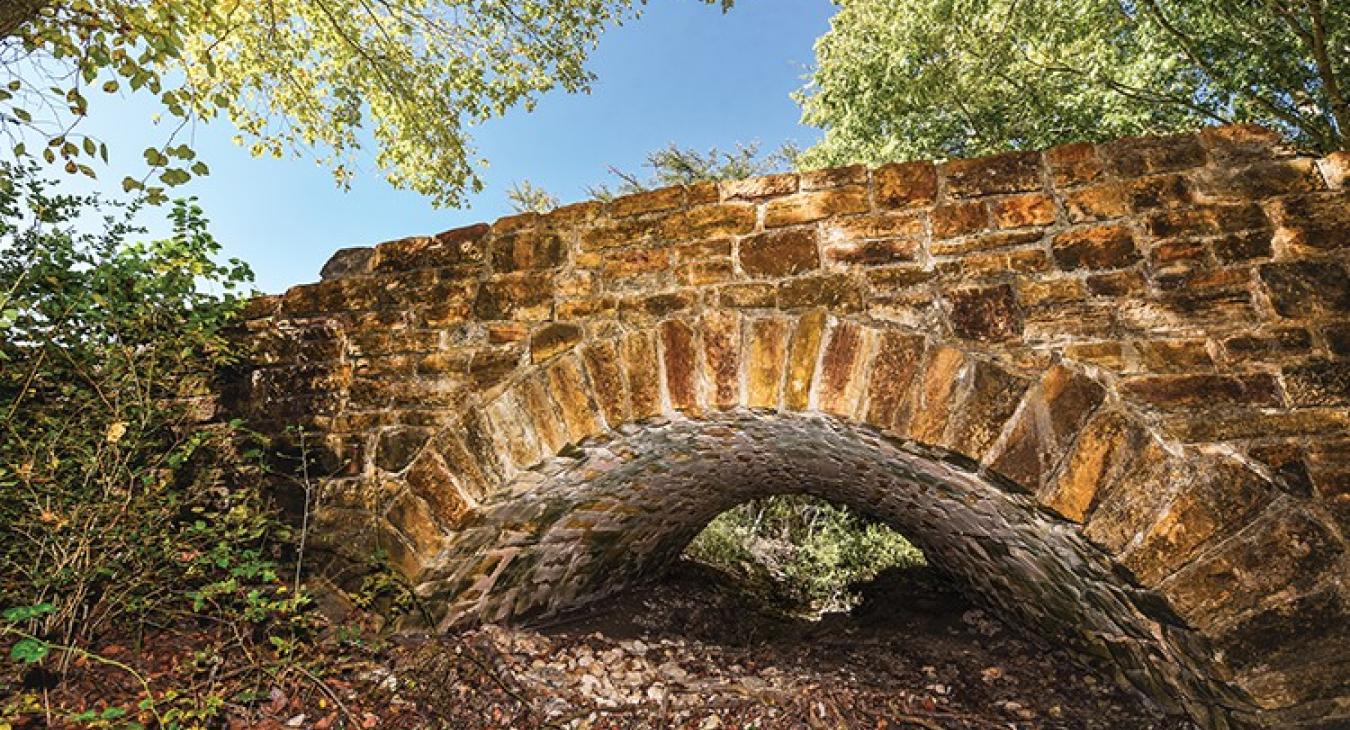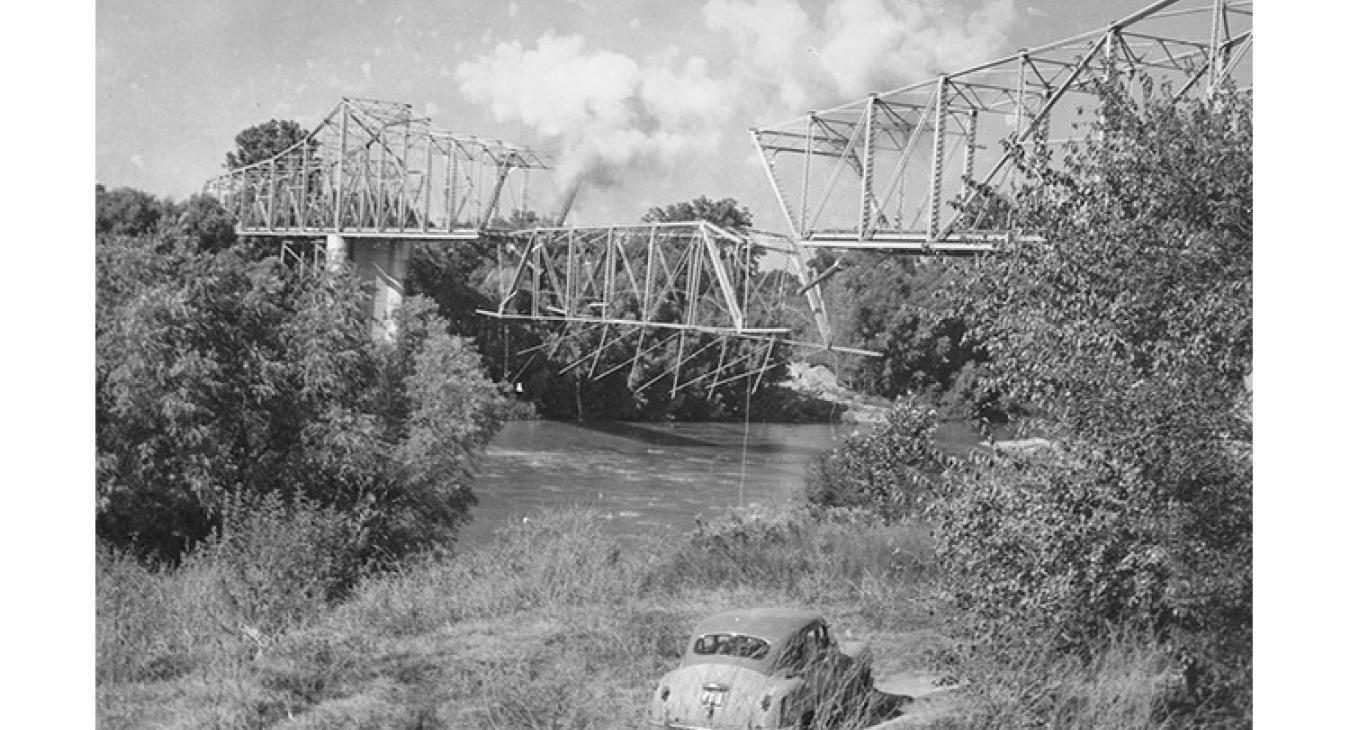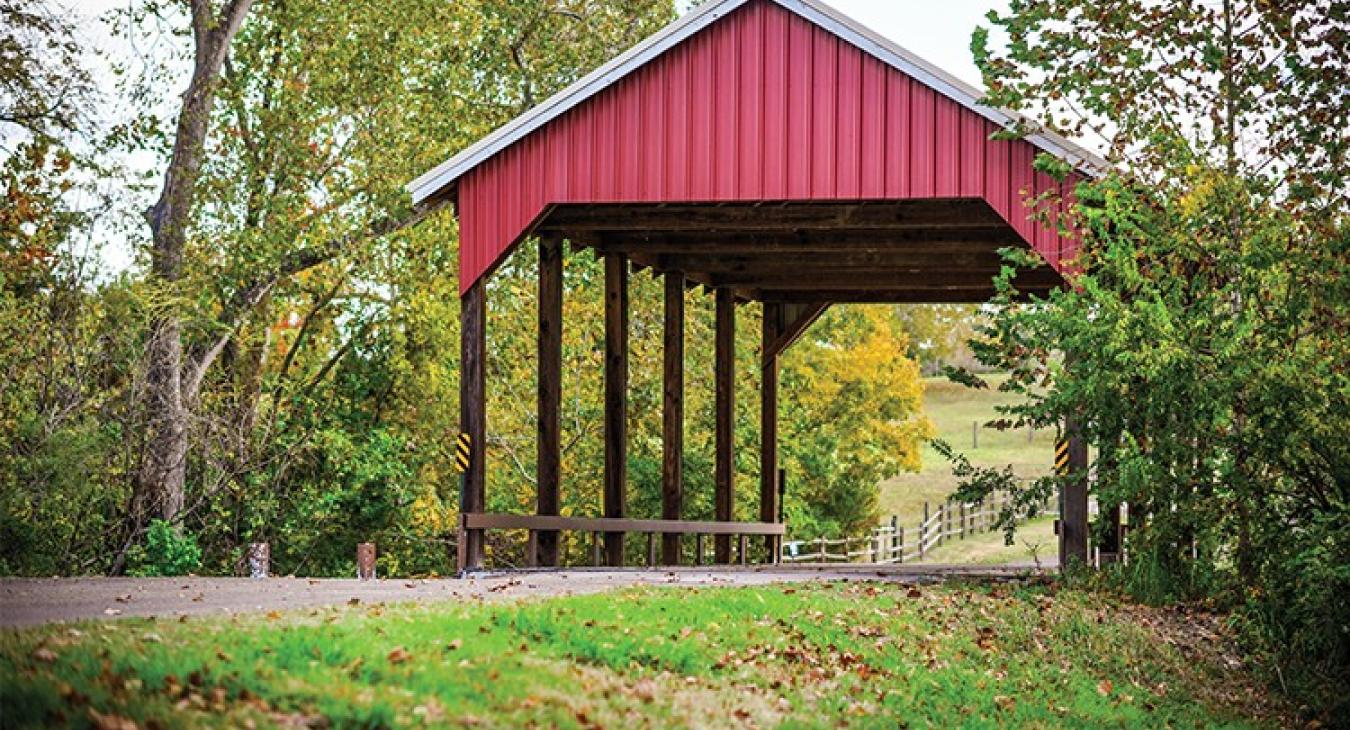Story by Denise Gamino
Photos by Sarah Beal
Bridges link us together, connecting what divides us.
They span time. They span space. They span history.
Bluebonnet Electric Cooperative’s region is dotted with bridges — old and new, small and large, well used and little traveled. We’ve highlighted a collection of area bridges that have colorful histories, interesting sights or good backstories. Two of the bridges no longer exist, so their stories are relegated to history. You can safely idle on the remaining bridges in these pages, then perhaps take a short drive or day trip and see them yourself.
1. Plum Creek bridge, Luling
Caldwell County
New York City has its famed High Line, an elevated old rail line transformed into a 1.5-mile pedestrian park that puts visitors at eye level with billboards and Manhattan apartment windows.
Luling offers a rural version of a miniature high line with the historic 1931 Plum Creek highway bridge that’s been preserved for pedestrians on the southeast edge of town. Visitors can walk high above rippling Plum Creek and stand eye to eye with the tree canopy. Pecans and bur oak acorns hang close at hand on adventurous branches that stretch into the bridge space, creating a green privacy curtain that can envelop visitors in summer.
The quarter-mile, dead-end bridge — which is now closed to vehicle traffic — is on the National Register of Historic Places.
It once served as the U.S. 183 bridge for travelers between Luling and Gonzales. But in 1999 a new highway opened next to the Depression-era bridge, and it went into retirement. Now it hides in plain sight, but most U.S. 183 motorists don’t even give it a glance.
The bridge looks like it doesn’t get much foot traffic, even though a welcoming sidewalk behind a Best Western hotel leads straight to it. These days, there’s a more popular draw just across nearby Interstate 10 — a large, crowded Buc-ee's convenience store with dozens of gas pumps.
Next time, opt for the solitude of the trees.
2. Black Bridge, Dime Box
Lee County
Someone in Dime Box recently asked retired Lee County Clerk Carol Dismukes a simple question: “What is that bridge doing here in the middle of town? There’s no water under it, and it doesn’t go anywhere."
The old, black iron structure perched unexpectedly in a park in Dime Box is “part of the history of Dime Box,” Dismukes said. “So many of the old-timers fondly remember that bridge.”
Around 1912, the single-span bridge was erected on private property about a mile east of Dime Box. The Houston and Texas Central Railway put the bridge on the farm of Asa Moses after he complained that railroad tracks cut his property in half, making it difficult for livestock and farm equipment to traverse his land.
The bridge, which became part of a county road, quickly became a popular place for courtship.
But by 1991, the bridge was abandoned when a new county road was built, so the Union Pacific Railroad arranged for a company to haul it away as scrap. However, the Dime Box Lions Club wanted to save the beloved bridge.
“We finally convinced (the metal recycling company) that we would move it if they would give it to us,’’ said Dismukes, club secretary.
The bridge, always known locally as Black Bridge because of its coat of paint, was moved in 1998 to land next to the Dime Box SPJST Lodge.
In 2015, the Lions Club moved it again to a park it had created one block from the main intersection in Dime Box (Stephen F. Austin Boulevard and Bowers Street). The inoperative bridge is in Black Bridge Park, at Bowers and Stewart streets, along with picnic tables, a historic oilfield pump jack and a volleyball court.
Wood planks are long gone, but the Lions Club is raising money to install a new bridge deck so pedestrians can walk across the bridge to nowhere.
“The bridge is important to the community,” Dismukes said. “It has meant a lot to be able to keep it."
3. Meadow Creek Lane covered bridge, near Chappell Hill
Washington County
In the rolling hills of Washington County, a red roof tops an unexpected covered bridge that evokes a bygone horse-and-buggy era.
The bridge was a labor of love for Houston land developer Terry Ward, who grew up in Ohio and never forgot the covered bridges he explored on childhood trips through Amish country.
“They were so cool,” he said. “We would get out and stand on the bridges. Those really fascinated me.”
Ward spent boyhood summers on his grandparents’ farm and later collected books about covered bridges. He moved to Houston after college to work in marketing for the Astros, then switched to the food business and opened two Dirty’s restaurants in Houston before shifting to real estate.
After shepherding commercial developments, Ward began building residential communities in rural areas. He bought tracts and walked the land to gather inspiration on how to create long-term emotional ties between buyers and the countryside.
“I got my covered bridge books out and said, ‘This is where I can do something different and create a feeling.’ I want to touch somebody in their heart and soul. I believe the covered bridge is a huge piece to that.”
You can drive on the two-lane black top bridge at the entrance to the Meadows of Chappell Hill neighborhood on Meadow Creek Lane off FM 2447, about 2.5 miles northeast of Chappell Hill.
4. Birch Creek bridge, near Lake Somerville State Park
Burleson County
A historic one-lane bridge in Burleson County could be a fishing fortune teller for Lake Somerville-area anglers.
The 90-year-old bridge on County Road 146 about four miles northwest of Lake Somerville State Park crosses over Birch Creek. When the creek water is up, local lore says white bass could be spawning — and biting —here and in other lake tributaries.
It was built in 1931 by the Monarch Engineering Co. of San Antonio (although some records say it was built in 1940). Heavy storms in recent years — including a record flood in 2015 — forced closure of all or parts of Lake Somerville State Park, but this steel truss bridge with wood planks endures.
“You can tell how high the water is in the lake by looking at the level in that creek,” said Tommy Snow, who worked for 23 years at the state park as a police officer before retiring from the Texas Parks and Wildlife Department.
The bridge makes a popular background for photos of new high school graduates, soon-to-be brides and grooms, and families.
Ben Tedrick, IT engineer for the Bryan-College Station Eagle, likes to drive over this Birch Creek bridge on his way to Somerville Lake, where he documents his adventures in a video blog called FishTales.
“Birch is a seasonal creek and often dry that far upstream (near the bridge), but like most watersheds in this area, when it floods, Birch Creek becomes more like a raging river,” Tedrick said.
The bridge is safe but is scheduled for rehabilitation in 2023, according to the Texas Department of Transportation.
Other than anglers, not many people use the Birch Creek bridge. Only about 70 cars a day crossed the 80-foot bridge in 2010 — an average of three cars an hour, according to the most recent data available.
If you are one of those few, check out the bridge’s sloping shape, known as a camelback configuration. It is considered a rare bridge type today.
And keep an eye out for a bald eagle. They nest at the nearby lake and could be hunting around the bridge.
5. CCC stone bridge, Lockhart State Park
Caldwell County
The pretty little sandstone bridge in Lockhart State Park doesn’t get much traffic. It’s easy to miss the little dirt road on the left just after you enter the park, but it leads to a historic bridge over a tributary of Clear Fork Creek.
During the Great Depression, young men in a New Deal jobs program earned $30 a month to lift heavy rocks from a nearby private quarry to build the arched span. Government rules required them to send $25 of their paycheck home to family.
From 1935-36, Company 3803 of the Civilian Conservation Corps also built a refectory, dance pavilion, stone water tower, park residence and dam in the 264-acre park, where trees drip with Spanish moss.
Trees surround the one-lane bridge, which now is closed to vehicles. Its semi-circular arched form can be traced to the architecture of ancient Rome.
“This is the most beautiful bridge in the park, but unfortunately, it is all but hidden to the public,” park interpreter Lauren Hartwick said. “Few who visit Lockhart State Park notice this beautiful relic.”
After visiting the bridge, head to the park’s short Hilltop Trail (a third of a mile, one way) to find some Hercules’ club trees, also known as toothache trees. The conspicuous bark is studded with triangular points, so the trunk looks like a giant spiked collar. Before dentistry, the tree was a toothache remedy because chewing a twig or leaf can numb the mouth.
6. Demise of 1915 bridge across the Colorado River, Smithville
Bastrop County
Smithville’s second bridge over the Colorado River — built in 1915 to replace a 1900 steel bridge that was destroyed in 1913 by a flood — no longer stands. But it made a spectacular — and very loud — exit.
The 1915 bridge crossed over the river and connected to Smithville’s now Main Street, about one third of a mile downriver of the current bridge, which was built in 1948. Vehicles used the 1915 bridge until the 1940s, when a military bulldozer being transported over the bridge caused severe structural damage to the span.
After the military accident closed the 1915 bridge, vehicle traffic was diverted to a temporary floating pontoon bridge built by the U.S. Army Corps of Engineers just upstream from the damaged bridge. The unusual stream of floating traffic made for good viewing by locals, who regularly flocked to the riverbank for picnics to watch the parade of cars.
The obsolete 1915 bridge finally was destroyed on Sept. 8, 1950, by a planned detonation that sent the center span crashing into the river. Smithville photographer Fred Moree captured the bridge’s final moment as it made its free fall.
7. Old Congress Avenue bridge, Richard Moya Park
Travis County
If you want to know what it was like to walk across the Colorado River in Austin in the 1880s, a time when today’s Capitol was being built, head to an eastern Travis County park just south of Austin-Bergstrom International Airport.
At the far eastern edge of Richard Moya Park, you can stroll the wood planks of a steel bridge originally built in 1884 as the Congress Avenue bridge. Look closely to see “Carnegie” stamped into the metal in some spots, a 19th century memento of what was once the largest steel company in the world — Carnegie Steel Corp.
This bridge was originally built over an undammed Colorado River in the Texas capital city as a six-span, through truss bridge, meaning the trusses are above and below the deck. It was designed by King Iron Bridge and Manufacturing Co. of Cleveland, Ohio. In 1910, the six-span bridge was dismantled and put into storage, replaced by a new Congress Avenue bridge.
The pieces of the old bridge didn’t rest long. In 1915, three of its spans were used in a road bridge across Onion Creek at a low-water passage called Moore’s Crossing. It was in an agricultural community that today is part of Richard Moya county park near FM 973. The bridge lasted less than a year. It washed away in a flood, to the dismay of locals.
Undeterred, Travis County elevated the bridge’s support piers by about 10 feet and erected the remaining three spans at the same spot over Onion Creek in 1922. It stands today at 58 feet above the creek and is 537 feet long and 20 feet high.
It was closed to vehicles more than 30 years ago, but pedestrians can use it today. The bridge top has floral scrollwork that seems a good fit for its current spot in a pastoral park dotted in the spring with wildflowers. From the bridge, visitors can see stately pecan trees that once were part of a pecan orchard. Pecan hunting in the park is still a popular — and lawful — activity in the fall.
8. Collapse of the old railroad bridge, West Point
Fayette County
Ever wonder why a chaotic or disastrous situation is commonly referred to as “a train wreck”? Startling photos of an incident on a railroad bridge over the Colorado River in 1961 vividly illustrate that metaphor.
On May 26 that year, a 98-car westbound Southern Pacific freight train carrying steel, auto parts and other cargo derailed while on the three-span T&NO (Texas and New Orleans) railroad bridge just north of the community of West Point in Fayette County, 12 miles west of La Grange. The event damaged a portion of the bridge, which was later replaced.
The wreck plunged some boxcars into the river while about 30 cars crashed into a heap on the south river bank. The Fayette County Record’s dramatic photo package shows one boxcar dangling from the single intact bridge span while another car balances part way off the span.
Four diesel engines and 26 cars had already crossed the river safely, and the last 26 cars and caboose stopped short of the river on the north side.
“As the cars derailed, they piled up like so many sticks of wood against the third span,” according to the newspaper. Two of the three 200-foot bridge spans were knocked down, leaving the bridge “virtually demolished,” the newspaper reported on May 31, 1961.
Railroad officials said some 12-foot steel forms carried as cargo shifted position and hit the bridge as the St. Louis-to-Los Angeles train crossed the Colorado. It took 150 men and heavy equipment to clean up the wreckage.
Today, the repaired railroad bridge still carries Union Pacific trains over the river.
9. Henderson Park bridge, Brenham
Washington County
The hard-working pedestrian bridge over Higgins Creek in Henderson Park has served several tours of duty — spanning three centuries in three places.
This 80-foot, 19th century bridge bore horses and buggies, Ford Model Ts as well as Ford Mustangs, school buses and even heavy farm equipment during more than 100 years of roadway service in Washington County. It carried traffic over creeks in two different locations before being saved from the scrapyard. In 1995, it was put in this park, famous for hosting decades of Juneteenth celebrations.
Each wooden plank of this tireless bridge reverberates with history.
“Henderson Park has been a wonderful place for the Black community for years and years, back to the 1920s — bringing in all kinds of wonderful events,” said Eddie Harrison, a retired Army colonel and former municipal court judge in Brenham. Harrison was interviewed before his death in November, 2020, at age 89. “The annual (Black high school) football games, annual conventions and especially Juneteenth were held there every year. Thousands of people would celebrate and enjoy themselves.”
Harrison best remembered the performance of blues singer Lightnin’ Hopkins.
The bridge was originally built in 1890-91 by Missouri Valley Bridge and Iron Works over Yegua Creek south of Somerville on what is now Texas 36. It is believed to be iron, not steel, even though you can see “Carnegie” stamped on some struts, signifying the famed Carnegie Steel Corp. Traffic outgrew the bridge, so it was replaced by a two-lane bridge circa 1926. The original pin-connected bridge, with its beam framework, was moved to Tommelson Creek on Cedar Hill Road, then to an unpaved road in farmland about six miles north of Brenham.
Growth in the area continued, and in 1994, the bridge again was replaced by a sturdier two-lane model. The state highway department gave the historic bridge to the City of Brenham for use in Henderson Park over Higgins Creek.
“The subject bridge is now a rare artifact of late nineteenth century bridge technology,” according to a 1997 Texas Department of Transportation report. “It is also a physical manifestation of the products and business practices of a bygone age.”
Henderson Park was created in the segregated 1920s to serve the Black community. It is next door to Fireman’s Park, the oldest park in Brenham.
“Beginning in the 1880s the Juneteenth celebration was regularly held (on land that later became Henderson Park). The park was once home to a large pavilion that hosted dances featuring legendary musicians, including B.B. King, (Big) Joe Turner, Little Richard and Cab Calloway. The park was also home to all of the athletic events for the Black community and host to a semi-professional baseball team,” according to a Brenham city history.
“That bridge had no better place to go,” Harrison said.
Download this story as it appeared in the Texas Co-op Power magazine »






